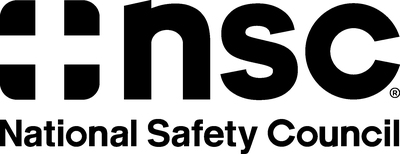Research paper examines why diversity, equity
and inclusion should be a foundational element of musculoskeletal
disorder prevention and provides equitable solutions to minimize
worker risks
WASHINGTON, June 10,
2024 /PRNewswire/ -- While efforts have been made in
recent years to increase workplace safety through regulations,
innovative technologies, hazard assessments and other methods,
research shows workers of color face more work-related injuries and
illnesses, according to data compiled by the Bureau of Labor
Statistics and the U.S. Census Bureau. Recognizing this disparity
and that musculoskeletal disorders, or MSDs, are the most common
workplace injury, the National Safety Council released a new
report, The Intersection of DEI and MSDs: Ensuring Equitable
Outcomes.

"At the National Safety Council, we believe fostering diversity,
equity and inclusion is not only a moral imperative but also
essential for creating safer and healthier work environments for
all," said Lorraine Martin, NSC
president and CEO. "This report, which analyzes the impact of
diversity, equity and inclusion on the largest category of
workplace injuries, underscores our commitment to advancing
equitable outcomes within the occupational safety landscape."
Published through the MSD Solutions Lab, a groundbreaking NSC
initiative established in 2021 with funding from Amazon (NASDAQ:
AMZN) to solve work-related MSDs, the research paper identifies
workplace factors that can lead to inequitable MSD outcomes and
provides solutions for mitigation. Specifically, the report
references more than 100 academic publications and sources and
examines the impact of diversity, equity and inclusion on work
organization, workplace and equipment design, safety culture,
psychological safety, and psychosocial risk factors. Key findings
center on:
- Work organization: Shift work, long hours and part-time
employee status can impact the prevalence of MSDs among workers.
Demanding work schedules can increase the risk of MSDs due to less
time for adequate sleep and recovery from work, longer exposure to
hazards and demands at work, and less time to attend to non-work
responsibilities. Other workplace factors highly associated with
MSD risk and prevalence are the type of job and the pace at which
work is done.
- Workplace and equipment design: An employee who uses a
wheelchair or an employee smaller than a fifth percentile female
may have difficulty accessing the full range of their workstation
depending on its design. PPE has also traditionally been designed
to fit the average White male and, as a result, females in the
workforce are often not provided with properly fitting gear. One
survey found that only 19% of women, non-binary and transgender
construction workers received appropriately sized gloves and safety
gear.
- Safety culture: Creating a strong safety culture is an
important factor in making sure workplaces are inclusive and safe
from MSD risks. Workplaces that do not offer benefits such as paid
sick leave and long-term disability may create an unsafe culture in
which employees feel insecure about taking necessary time off when
they have suffered a workplace injury. Clear and accessible
policies and procedures are vital to ensuring organizations are
equitably protecting all workers from safety risks.
- Psychological safety: Employee wellbeing at work is
significantly influenced by a sense of belonging to the
organization or team, with managers showing appreciation for their
employees and involving them in decision-making. Voice suppression
can prove particularly harmful to employees of color, as they may
already perceive their voices and opinions as less valued than the
majority group. As a result of this disparity, Black and Hispanic
workers report the most unease about reporting unsafe work
conditions when compared to other racial and ethnic groups.
- Psychosocial risk factors: Common psychosocial risk
factors are job stress, lack of job control or autonomy, job
dissatisfaction, time pressure and poor organizational, supervisor
or coworker support. Occupational stress has shown to increase
MSDs, with role conflict and lack of job control leading to wrist,
hand, shoulder and lower back issues. Further, psychosocial risks
are more pervasive in jobs and industries commonly employing
workers of color and female workers.
In addition to examining the impact of workplace factors on
MSDs, the report also outlines potential solutions to address
inequities and risks based on the hierarchy of controls,
including:
- Elimination: Be mindful of jobs that demand high
exertions, awkward or sustained postures, and a fast pace and
eliminate them when able.
- Substitution: Adapt workplace design to those with
different sizes and abilities and provide ergonomic accommodations
for employees with medical conditions or disabilities.
- Engineering: Provide adjustable assistive devices and
technology – including lifts, ramps, hoists, cobots, carts,
counterbalances, turntables and conveyors – to minimize strain and
repetitive motions and incorporate designs respecting different
cultural norms and practices.
- Administrative: Utilize policies and procedures to
ensure accessibility for all workers, an open and anonymous
reporting system, and promote diverse representation in safety
leadership and training materials. Further, it is essential to seek
and include feedback on job tasks and risk factors from a diverse
group of employees to source solutions that are helpful for
everyone.
- PPE: Routinely check in with employees to confirm PPE
needs are being appropriately met, including those with different
body types, abilities and cultural preferences.
Pioneering research is one of several initiatives supported by
the MSD Solutions Lab to achieve its goal of preventing MSDs. To
learn more about these efforts and the risks associated with MSDs,
visit nsc.org/msd.
About the National Safety Council
The National Safety Council is America's leading nonprofit safety
advocate – and has been for 110 years. As a mission-based
organization, we work to eliminate the leading causes of
preventable death and injury, focusing our efforts on the workplace
and roadways. We create a culture of safety to not only keep people
safer at work, but also beyond the workplace so they can live their
fullest lives.
Connect with NSC:
Facebook
Twitter
LinkedIn
YouTube
Instagram
 View original content to download
multimedia:https://www.prnewswire.com/news-releases/national-safety-council-releases-new-report-on-diversity-equity-and-inclusion-and-workplace-injury-prevention-302167636.html
View original content to download
multimedia:https://www.prnewswire.com/news-releases/national-safety-council-releases-new-report-on-diversity-equity-and-inclusion-and-workplace-injury-prevention-302167636.html
SOURCE National Safety Council